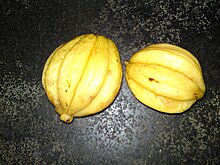Garcinia gummi-gutta
| Garcinia gummi-gutta | |
|---|---|

| |
| Scientific classification | |
| Kingdom: | Plantae |
| Clade: | Tracheophytes |
| Clade: | Angiosperms |
| Clade: | Eudicots |
| Clade: | Rosids |
| Order: | Malpighiales |
| Family: | Clusiaceae |
| Genus: | Garcinia |
| Species: | G. gummi-gutta
|
| Binomial name | |
| Garcinia gummi-gutta | |
| Synonyms[2] | |
| |
Garcinia gummi-guttais atropicalspeciesofGarcinianative toSouth AsiaandSoutheast Asia.[2][3]Common names includeGarcinia cambogia(a former scientific name), as well asbrindle berry,andMalabar tamarind.[4]Thefruitlooks like a smallpumpkinand is green to pale yellow in color.[5]
Although it has received considerable media attention purporting its effects onweight loss,there are reports ofliver toxicityassociated with theHydroxycutcommercial preparation containing the fruit extract, with clinical evidence indicating it has no significant effect on weight loss.[4][5][6]
Cultivation


Garcinia gummi-guttais grown for its fruit inSoutheast AsiaandSouth Asia.Garcinia gummi-guttais one of several closely relatedGarciniaspecies from the plant familyClusiaceae.[2][3]With thin skin and deep vertical lobes, the fruit ofG. gummi-guttaand related species range from about the size of an orange to that of a grapefruit;G. gummi-guttalooks more like a small yellowish, greenish, or sometimes reddish pumpkin.[7]The color can vary considerably. When the rinds are dried and cured in preparation for storage and extraction, they are dark brown or black in color.[citation needed]
Phytochemicals
Although few high-quality studies have been done to define the composition of the fruit, itsphytochemicalcontent includeshydroxycitric acidwhich isextractableand developed as adietary supplement.[5][6][8]Other compounds identified in the fruit include thepolyphenols,luteolin,andkaempferol.[9]
Common names
In theMalabar Coast,it is known askudam puliand in Tamil speaking areas ofSri Lankaand India, it is calledgoraka.[10][11]
Weight loss claims
In late 2012, a United Statescelebrity doctor,Dr. Oz,promotedGarcinia cambogiaextract as "an exciting breakthrough in natural weight loss".[12][13]Dr. Oz's endorsements ofdietary supplementshaving no or little scientific evidence of efficacy have often led to a substantial increase in consumer purchases of the promoted products.[13]
While it has received considerable media attention purporting impact onweight loss,the evidence forGarcinia cambogiasupports no clear effect,[4][5][14][15]while gastrointestinal adverse events were two-fold more common over theplaceboin a 2011meta-analysis,indicating the extract may be unsafe for human consumption.[5][6]Adverse events associated with use of such supplements ( "side effects") — especially,liver toxicity,as well asgastrointestinalissues — led to one preparation being withdrawn from the market.[16]
Adverse effects
In addition to possible liver damage, hydroxycitric acid can causedry mouth,nausea,gastrointestinaldiscomfort, andheadaches.[5][17]
Drug interactions
There is potential forGarcinia cambogiato interfere withprescription medications,including those used to treat people withdiabetes,asthma,andclottingdisorders.[5]
Culinary

Garcinia gummi-guttais used in cooking, including in the preparation of curries to add a sour flavor.[5]The fruit rind and extracts ofGarciniaspecies are used in many traditional recipes used in food preparation in Southeast Asian countries.[4][18]In the IndianAyurvedic medicine,"sour" flavors are said to activate digestion. The extract and rind ofG. gummi-guttais acurrycondiment in India.[18][19][20]It is an essential souring ingredient in the southern Thai variant ofkaeng som,a sour curry.[21][22]
Gallery
-
Bark
-
Cross section
-
Drying in smoke
See also
References
- ^Deepu, S.; Geethakumary, M.P. (2020)."Garcinia gummi-gutta".IUCN Red List of Threatened Species.2020:e.T117894456A117894469.doi:10.2305/IUCN.UK.2020-3.RLTS.T117894456A117894469.en.Retrieved13 May2024.
- ^abc"Garcinia gummi-gutta(L.) N.Robson ".World Checklist of Selected Plant Families.Royal Botanic Gardens, Kew.Retrieved1 June2013– viaThe Plant List.Note that this website has been superseded byWorld Flora Online
- ^ab"Garcinia gummi-gutta".Germplasm Resources Information Network.Agricultural Research Service,United States Department of Agriculture.Retrieved11 December2017.
- ^abcd"Garcinia cambogia".National Center for Complementary and Integrative Health, US National Institutes of Health. 1 December 202.Retrieved25 September2021.
- ^abcdefgh"Garcinia cambogia".Drugs.com. 28 May 2020.Retrieved25 September2021.
- ^abcOnakpoya, Igho; Hung, Shao Kang; Perry, Rachel; Wider, Barbara; Ernst, Edzard (2011)."The Use of Garcinia Extract (Hydroxycitric Acid) as a Weight loss Supplement: A Systematic Review and Meta-Analysis of Randomised Clinical Trials".Journal of Obesity.2011(December 14): 509038.doi:10.1155/2011/509038.PMC3010674.PMID21197150.
- ^"Fruit yellowish or reddish, size of an orange having six or eight deep longitudinal grooves in its fleshy pericarp. Pulp acid of a pleasant flavor. It is dried among the Singalese who use it in curries."Uphof, J.C. Th.(1968).
- ^Yamada T, Hida H, Yamada Y (2007). "Chemistry, physiological properties, and microbial production of hydroxycitric acid".Appl. Microbiol. Biotechnol.75(5): 977–82.doi:10.1007/s00253-007-0962-4.PMID17476502.S2CID25194835.
- ^Sulaiman, C. T; Balachandran, I (2017)."LC/MS characterization of phenolic antioxidants of Brindle berry (Garcinia gummi-gutta (L.) Robson)".Natural Product Research.31(10): 1191–1194.doi:10.1080/14786419.2016.1224871.PMID27583573.S2CID29342259.
- ^Sarip, Nur Aqilah; Aminudin, Nurul Iman; Danial, Wan Hazman (12 September 2021)."Green synthesis of metal nanoparticles using Garcinia extracts: a review".Environmental Chemistry Letters.20:1.doi:10.1007/s10311-021-01319-3.S2CID237487258.
- ^Pramanik, Malay; Diwakar, Atul Kumar; Dash, Poli; Szabo, Sylvia; Pal, Indrajit (1 April 2021)."Conservation planning of cash crops species (Garcinia gummi-gutta) under current and future climate in the Western Ghats, India ".Environment, Development and Sustainability.23(4): 5345.Bibcode:2021EDSus..23.5345P.doi:10.1007/s10668-020-00819-6.S2CID220051712.
- ^The Dr. Oz Show (November 5, 2012).Garcinia Cambogia: The Newest, Fastest Fat-BusterArchived2014-04-21 at theWayback Machine.
- ^abChristensen, Jen; Wilson Jacque (19 June 2014)."Congressional hearing investigates Dr. Oz 'miracle' weight loss claims".CNN Health.Retrieved18 September2016.
- ^Heymsfield, S. B.; Allison, D. B.; Vasselli, J. R.; Pietrobelli, A.; Greenfield, D.; Nunez, C. (1998)."Garcinia cambogia (Hydroxycitric Acid) as a Potential Antiobesity Agent: A Randomized Controlled Trial".J. Am. Med. Assoc.280(18): 1596–1600.doi:10.1001/jama.280.18.1596.PMID9820262.
- ^Crescioli, Giada; Lombardi, Niccolò; Bettiol, Alessandra; Marconi, Ettore; Risaliti, Filippo; Bertoni, Michele; Menniti Ippolito, Francesca; Maggini, Valentina; Gallo, Eugenia; Firenzuoli, Fabio; Vannacci, Alfredo (2018-05-25)."Acute liver injury following Garcinia cambogia weight-loss supplementation: case series and literature review".Internal and Emergency Medicine.13(6): 857–872.doi:10.1007/s11739-018-1880-4.hdl:2158/1244214.ISSN1828-0447.PMID29802521.S2CID44094323.
- ^Lobb, A. (2009)."Hepatoxicity associated with weight-loss supplements: A case for better post-marketing surveillance".World Journal of Gastroenterology.15(14): 1786–1787.doi:10.3748/wjg.15.1786.PMC2668789.PMID19360927.
- ^Soni, MG (2004). "Safety assessment of (-)-hydroxycitric acid and Super CitriMax, a novel calcium/potassium salt".Food Chem Toxicol.42(9): 1513–29.doi:10.1016/j.fct.2004.04.014.PMID15234082.
- ^ab"The acid rinds of the ripe fruit are eaten,."Drury, Heber (1873)."Garcinia gambogia(Desrous) N. 0. Clusiaceae ".The Useful Plants of India, second edition.London: William H. Allen & Co. p. 220.
- ^"G. Gummi-Gutta (Garcinia Cambogia) – An Ancient Indian Curry Condiment".US Premium Garcinia Cambogia. Archived fromthe originalon 31 January 2019.Retrieved5 May2015.
- ^"Kudampuli meencurry (fish curry with Malabar tamarind)".Secret Indian Recipe. Archived fromthe originalon 30 April 2018.Retrieved5 May2015.
- ^"Kaeng Som Kung (Sour Curry with Shrimp)".Saveur. 26 February 2015.Retrieved5 May2015.
- ^"Gaeng Som Recipe, Thai Sour Curry Recipe of Shrimp, Okra and Roselle Leaves".Thai Food Master. 30 March 2011.Retrieved5 May2015.




